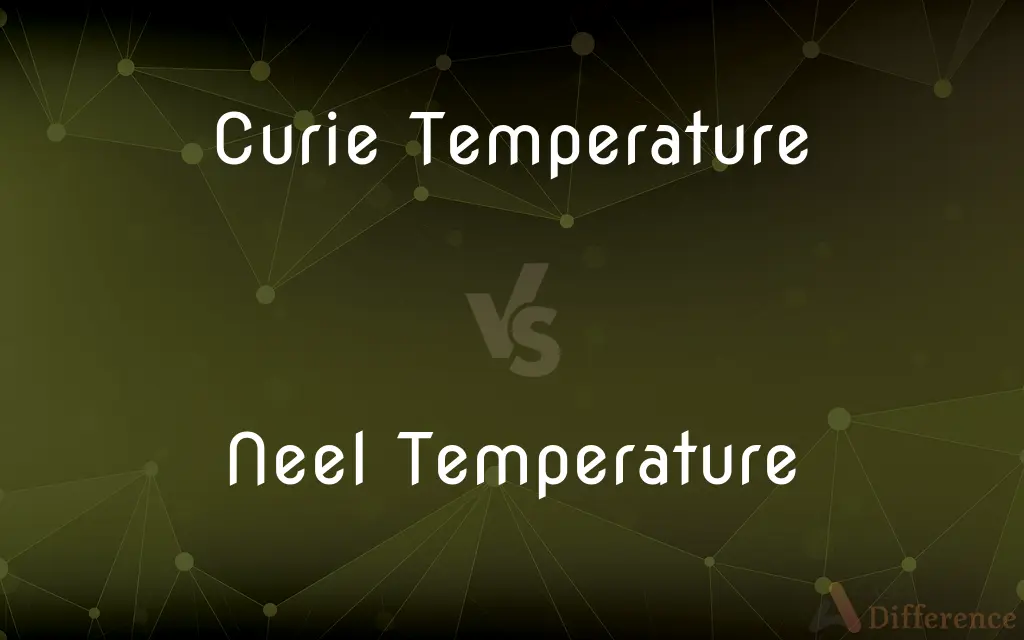Curie Temperature vs. Neel Temperature — What's the Difference?
By Tayyaba Rehman — Published on November 4, 2023
Curie Temperature pertains to the temperature above which ferromagnetic materials become paramagnetic. Neel Temperature refers to the threshold above which antiferromagnetic materials become paramagnetic.

Difference Between Curie Temperature and Neel Temperature
Table of Contents
ADVERTISEMENT
Key Differences
Curie Temperature and Neel Temperature: Their Specific Definitions: Curie Temperature defines the precise point at which ferromagnetic materials transition to a paramagnetic state due to thermal energy. Neel Temperature is designated as the temperature at which antiferromagnetic materials shift to a paramagnetic phase. Both signify critical shifts in magnetic behavior, albeit in different material types.
Role of Thermal Energy in Curie and Neel Temperature: Thermal energy disrupts magnetic alignment in materials, with Curie Temperature representing this for ferromagnetic materials. In contrast, Neel Temperature represents the same disruptive effect of thermal energy but on antiferromagnetic materials. Each delineates the thermal energy level causing a shift in magnetic order within different material types.
Magnetic Behavior Above Curie and Neel Temperature: Above the Curie Temperature, ferromagnetic materials lose their spontaneous magnetization. Contrarily, antiferromagnetic materials lose their antiparallel magnetic alignment when exceeding the Neel Temperature. Both temperatures indicate a state where thermal agitation overcomes magnetic ordering, albeit describing distinct magnetic order disruptions.
Microscopic Insights into Curie and Neel Temperature: The Curie Temperature underscores a macroscopic transition that emanates from microscopic changes in the magnetic dipoles’ alignment within ferromagnetic materials. Simultaneously, the Neel Temperature speaks of a similar macroscopic transition, but stemming from shifts in the antiparallel alignment of adjacent magnetic dipoles in antiferromagnetic materials.
Curie and Neel Temperature in Magnetic Materials Research: Researchers explore Curie Temperature to understand and utilize ferromagnetic materials’ properties, while the Neel Temperature is explored in the context of antiferromagnetic materials. Despite studying different materials and magnetic order types, both temperatures are pivotal in the magnetic materials research domain, assisting in technological advancements and applications.
ADVERTISEMENT
Comparison Chart
Type of Material
Ferromagnetic materials
Antiferromagnetic materials
Magnetic Order Change
From ferromagnetic to paramagnetic
From antiferromagnetic to paramagnetic
Impact of Temperature
Eliminates spontaneous magnetization
Destroys antiparallel magnetic alignment
Research Significance
Crucial in studying ferromagnetic materials
Vital for understanding antiferromagnetic materials
Technological Use
Employed in designing magnetic storage devices
Useful in developing spintronic technologies
Compare with Definitions
Curie Temperature
Curie Temperature is where the thermal energy outweighs the magnetic exchange energy in ferromagnetics.
The Curie Temperature dictates the operational limit for magnetic data storage units.
Neel Temperature
It signifies a change in magnetic ordering due to overwhelming thermal fluctuations in antiferromagnetics.
Approaching Neel Temperature, the magnetic susceptibility of antiferromagnetic materials peaks.
Curie Temperature
Curie Temperature is defined through the mean field theory in statistical physics.
Physicists calculate the Curie Temperature to predict a material’s magnetic properties at different temperatures.
Neel Temperature
Neel Temperature is crucial in understanding the magnetic and thermal properties of antiferromagnetic materials.
Scientists study Neel Temperature to explore antiferromagnetic materials for magnetic cooling applications.
Curie Temperature
It represents a phase transition from a magnetically ordered to a non-ordered state.
Studying the Curie Temperature of various alloys aids in developing efficient magnetic materials.
Neel Temperature
Neel Temperature describes the threshold at which antiferromagnetic materials become paramagnetic.
Above the Neel Temperature, antiferromagnetic oxides lose their magnetic sublattice ordering.
Curie Temperature
It serves as a critical point in studying magnetic behaviors and applications in technology.
The Curie Temperature of a material informs the design principles of electromagnetic devices.
Neel Temperature
It delineates a critical point influencing antiferromagnetic properties and their technological applications.
Considering Neel Temperature is crucial while exploring antiferromagnets in spintronic applications.
Curie Temperature
Curie Temperature is the temperature at which ferromagnetic materials lose their magnetic order.
The Curie Temperature of iron is about 770°C, above which it becomes paramagnetic.
Neel Temperature
Neel Temperature elucidates a phase change resulting from shifts in antiparallel magnetic alignment.
At the Neel Temperature, the entropy of an antiferromagnetic system experiences a significant change.
Common Curiosities
Are Curie Temperature and Neel Temperature related to magnetism?
Yes, both temperatures are related to changes in magnetic properties of materials.
What is Curie Temperature?
Curie Temperature is the temperature above which a ferromagnetic material becomes paramagnetic.
How does a material behave above the Curie Temperature?
Above the Curie Temperature, a ferromagnetic material loses its magnetic ordering and becomes paramagnetic.
Is Curie Temperature only associated with ferromagnetic materials?
Yes, Curie Temperature specifically describes the transition point for ferromagnetic materials.
What is Neel Temperature?
Neel Temperature is the temperature above which an antiferromagnetic material becomes paramagnetic.
Why is the Curie Temperature significant?
Curie Temperature is crucial because it defines the operational limits for devices or applications using ferromagnetic materials.
How does a material behave above the Neel Temperature?
Above the Neel Temperature, an antiferromagnetic material loses its antiparallel magnetic ordering and turns paramagnetic.
Is Neel Temperature only associated with antiferromagnetic materials?
Yes, Neel Temperature specifically pertains to antiferromagnetic materials.
Who discovered the Curie Temperature?
The Curie Temperature is named after Pierre Curie, who studied the magnetic properties of materials.
Can a material have both a Curie and Neel Temperature?
Typically, a material will have either a Curie Temperature or a Neel Temperature, but not both, as they relate to different types of magnetic ordering.
How is the Neel Temperature determined?
Neel Temperature can also be determined using magnetometry, among other techniques, by observing changes in the magnetic response of the material with temperature.
Why is the Neel Temperature significant?
Neel Temperature is essential in understanding the magnetic behavior of antiferromagnetic materials, especially in technological applications.
Are Curie Temperature and Neel Temperature affected by external pressures?
Yes, both temperatures can be influenced by external pressures, which can cause shifts in their values.
Who discovered the Neel Temperature?
The Neel Temperature is named after Louis Néel, who made significant contributions to the study of antiferromagnetism.
How is the Curie Temperature determined?
Curie Temperature can be determined using various experimental techniques, including magnetometry, where the material's magnetization is measured as a function of temperature.
Share Your Discovery

Previous Comparison
Black vs. Jet Black
Next Comparison
Prunes vs. DatesAuthor Spotlight
Written by
Tayyaba RehmanTayyaba Rehman is a distinguished writer, currently serving as a primary contributor to askdifference.com. As a researcher in semantics and etymology, Tayyaba's passion for the complexity of languages and their distinctions has found a perfect home on the platform. Tayyaba delves into the intricacies of language, distinguishing between commonly confused words and phrases, thereby providing clarity for readers worldwide.












































